“We were so ready for this because the teachers at the Aquarium made us comfortable with being in the real ocean. We knew we were safe.”
So said one of my middle school students after snorkeling last spring at the Catalina Island Marine Institute (CIMI).
I had wondered how my young student scientists would respond. Would they cringe away from the speeding seals, flee in terror from the bloody sight of top smelt being devoured, or be thrilled to their very marrow at the physical proximity of wild marine mammals?
As three young harbor seals closely tore through our group of swimmers, in pursuit of the bait ball we ourselves had been trailing, my heart warmed as my young scientists responded with wonder and awe instead of fear or confusion. Joy, tempered with an accurate understanding of ocean food webs, had prepared them, quite literally, to dive deeply into marine science with an invigorating boldness that belied their youth. My adolescent students relished this potentially scary encounter, despite the cold water, sense of risk, and hard work such experiential learning can entail because they had personal experience of the ocean and strong content knowledge gained through frequent visits to the Heal the Bay’s Santa Monica Pier Aquarium.
As I reflect on 10 years of teaching and learning in partnership with the stellar staff at Heal the Bay’s pier aquarium, my student’s acquisition of this knowledge based confidence, experience based competence, and persistent engagement with Southern California’s marine environments is the most obvious reward. However, this yearly educational series offered by Aquarium staff to my students at Santa Monica Alternative School House, is merely the tip of a large iceberg. Heal the Bay staff have cheerfully deployed their generous souls again and again when confronted with young people who needed lessons more important then genus and species names.
Four brief examples make it clear that marine science is just one of this talented staff’s specialties: Heal the Bay Education Director Tara Treiber acted as a personal mentor to two young girls who were “lost” in some adult’s estimation. She found places for them to intern, followed their progress, and poured a current of caring over them, washing them safely back in the direction of health and productivity. Both are thriving in their schools now and one of the two has taking up scuba diving so she may remain close to the ocean she professes to love. A better example of “just in time” mentoring of adolescents could not be found, as this was definitively a turning point for these girls. Viewed from the comfortable perspective of time, a turning point that turned positive! The girl’s parents would tell you that the relationships formed at the Aquarium with the people of Heal the Bay “saved” them.
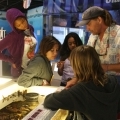
Nick Fash [Aquarium Education Specialist] is cited by at least three former students as the inspiration for their marine biology related majors at college. A fourth student now at Georgetown is considering environmental law, similarly influenced by Heal the Bay’s philosophy of science-based activism and his experience testifying at public hearings. Amanda Jones’ (also an Aquarium educator) teaching continues to elicit promises from perennially distracted and rowdy 8th graders to make “perfect choices” as she makes things “so interesting.”
Three teenage girls still covered in the mud, scratches, and grime from plant removal activities in the Malibu Creek watershed vowed to be “to be scientists just like Sarah Sikich [Heal the Bay’s Coastal Resources Director].” Personal generosity, woven into professional people of accomplishment, who care far beyond their job descriptions, is central to my experience of partnering with the Aquarium over the last 10 years and a magnificent starting point for considering the next 10. I would swim with these fine people anywhere!
Next, I’ll share some of the stories of science-based activism that my students and Heal the Bay have partnered on over the years.
— Kurt Holland, middle school teacher at SMASH
As we commemorate a decade operating our Aquarium, we’re highlighting our history as well as previewing our plans for the NEXT 10 years.
If you haven’t already, come visit our Aquarium, located on the Santa Monica Pier, just below the carousel. Join us the first weekend of March to celebrate our 10-year anniversary!



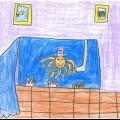
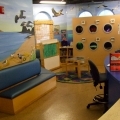 Peer into the “holdfast haven” exhibit, for example, for a close look at the root-like structure, known as a holdfast, which is the anchor of the giant kelp. Chances are a keen eye will see a collection of crustaceans called Hemphill’s kelp crabs. Their first pair of walking legs is exceptionally long, and covered with numerous curved hairs. They decorate this pair of legs with kelp, grass, algae and other organisms. When feeling threatened, this crab will raise one of its adorned legs and hold it horizontally as a shield between itself and a predator. The Hemphill’s kelp crabs were just added to the holdfast, also home to brittle stars, snails and other tiny organisms. Visitors are charmed by their antics, but at least weekly someone will ask: “whatever happened to that octopus that flooded the Aquarium?”
Peer into the “holdfast haven” exhibit, for example, for a close look at the root-like structure, known as a holdfast, which is the anchor of the giant kelp. Chances are a keen eye will see a collection of crustaceans called Hemphill’s kelp crabs. Their first pair of walking legs is exceptionally long, and covered with numerous curved hairs. They decorate this pair of legs with kelp, grass, algae and other organisms. When feeling threatened, this crab will raise one of its adorned legs and hold it horizontally as a shield between itself and a predator. The Hemphill’s kelp crabs were just added to the holdfast, also home to brittle stars, snails and other tiny organisms. Visitors are charmed by their antics, but at least weekly someone will ask: “whatever happened to that octopus that flooded the Aquarium?”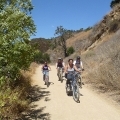
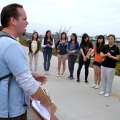
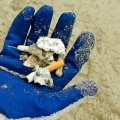
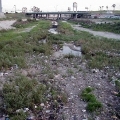
 The Hawaii survey turned up masses of typical ocean garbage, including fishing nets and traps, Mallos said, noting the irony of also finding a “Heal the Bay” trashcan.
The Hawaii survey turned up masses of typical ocean garbage, including fishing nets and traps, Mallos said, noting the irony of also finding a “Heal the Bay” trashcan.